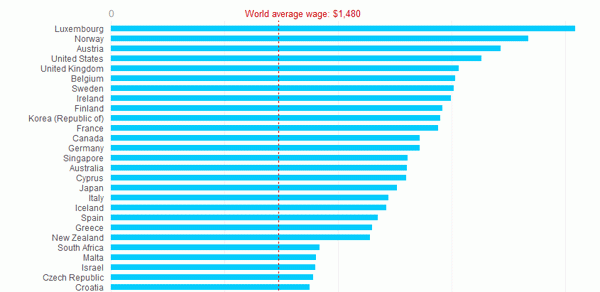One of the main indicators of the success of economic policy in a country is the income of its citizens. Most often, when evaluating it, an indicator such as the average wage is used. It allows you to find out the income level of an average citizen, although, of course, it also has its drawbacks. Let's find out what the average wage of workers and employees in Russia, as well as in other countries, is equal to.
The essence of the term "average wage"
The average salary, according to the methodology, is calculated by dividing the total salary per unit of time (year, month, etc.). This calculation is carried out in order to determine what income a particular person received for a certain period. If we take this definition in the context of an entire region or state, then, among other things, the total salary should be divided by the number of all persons employed in this territory. The result of these calculations is called per capita income. In addition, there is a calculation of average wages in the context of a specific industry National economy. In this case, the same scheme is applied, but only data for a specific sector of the economy are taken into account.
The disadvantages of this indicator
At the same time, the average wage cannot be the only indicator characterizing the living standards in the country, since the price factor should also be taken into account. But there are other drawbacks to this averaged approach. For example, the calculation of average wages does not take into account the moment of social stratification. If you exaggerate, then the average wage of five people, of which four receive a thousand rubles a month, and one - a million, is 200 800 rubles a month. But this says almost nothing about the real income of these five people.
In addition, the average wage in the country does not include income received not at the official place of work or in the absence of registration. The so-called salary in envelopes is not included in her calculation.
Practical calculations
The average wage of workers and employees in the country is taken into account primarily for statistical purposes, to determine the income level of citizens, as well as to compare it with the corresponding indicators of other states. In addition, sometimes this indicator is used when calculating specific budget items of a country or region.
For each individual person, the average salary can also be calculated. Its calculation is carried out for various purposes. For example, a person may apply for it when applying to government bodies for subsidies, material assistance, or for a loan from a bank. In these cases, confirmation of the calculation is a certificate of average wage. In addition, the calculation is made directly at the enterprise - to determine the size of vacation, sick leave and other payments. In this case, a certificate of average wage is not required, everything is regulated by on-farm calculations, according to the Labor Code and other legal acts.
Although the list of possible options is not limited to this list.
Calculation procedure in Russia
The procedure for calculating the average wage in Russia is regulated by laws and decrees of state bodies of the Russian Federation. In particular, the Decree of the Government of the Russian Federation No. 922 of December 24, 2007 and the Labor Code are taken as a basis.
According to these legal acts, the average salary of employees of enterprises and organizations is calculated over the last twelve months of the work of a particular person in the enterprise in the amount of income actually accrued to him and the time actually worked. The calculation period is taken for the last full month inclusive.
The average wage includes all types of material remuneration for labor received at a particular enterprise, including surcharges, allowances and bonuses. Payments of a social nature and all income that are not related to payment of labor activity are not taken into account. For example, material assistance, business trips, reimbursement of previously spent funds for household needs and so on.
Help on average earnings
The certificate of average salary for determining the size of a citizen's income is a document that confirms the corresponding calculations. There is no single form established for the Russian Federation. Therefore, the format of this document is often arbitrary. This primarily relates to certificates issued for submission to various banking institutions.
But the arbitrariness of the form does not negate the presence of mandatory details. The certificate must indicate the surname, name, patronymic of the employee, company name, date of issue, signature of the head, period for which the average wage, monthly breakdown of earnings and the total average amount are calculated.
But nevertheless, there are cases when individual organizations, to which a person applies, require the provision of an approved document. Most often, they themselves issue a certificate form to fill out at the enterprise. First of all, this applies to government agencies. For example, in order to receive a subsidy you will have to bear a certificate confirming your average salary of a strictly established standard.
Each enterprise must issue the mentioned document at the request of its employee.
Dynamic indicators of average wages in Russia
The arithmetic average wage in Russia for the years after the collapse of the USSR fluctuated very much. So, at the time of the collapse of the Union in December 1991, this figure was 101.36 in terms of dollars. In 1992, he reached his minimum. Then the average monthly income of a Russian was only 23.96 dollars. Significant growth began in the following years, and the arithmetic average wage in Russia exceeded $ 180 per month. But then a default followed, and the average salary in 1999 again fell to almost $ 73.
After the denomination of the ruble and default, a slow but steady increase in average wages began. In 2013, it reached a peak in dollar terms and amounted to $ 856, or 26.6 thousand rubles. But then came the economic crisis and the devaluation of the ruble. This led to the fact that, although in 2015 the average wage increased to 30 thousand rubles, in dollar terms it almost halved, compared to 2013, and amounted to $ 449.
The forecast for the near future remains disappointing. A small increase in the average wage in rubles is expected in the short term, but at the same time, the level of salaries in the dollar equivalent, as well as real incomes of the population will decrease. Actually, this trend has already been observed recently. How much the fall will be strong depends largely on the development of the further economic situation in the country as a whole.
The average salary in the regions of Russia
In Russia in 2015, the highest average wage of workers was in Moscow. It reaches the size of 60.8 thousand rubles, which is almost two times more than the average Russian level. Then follows the Nenets Autonomy - 54.1 thousand rubles, Chukot Autonomy - 51.0 thousand rubles, Magadan Region - 50.8 thousand rubles, the Republic of Sakha - 48.6 thousand rubles.The lowest average salary of workers in Russia was recorded in Novosibirsk (16.0 thousand rubles) and Kemerovo (15.9 thousand rubles) regions.
Thus, the largest average salary in the Russian Federation is paid in the capital and in the Far Eastern Federal District, and the smallest - in some regions of Siberia.
Average salary by industry
By industry, the average wage is also calculated. Its definition is carried out by dividing the total income of all people employed in a particular sector of the national economy by their number and by the period of time that they actually worked.
The highest level of salary in 2014 was among people employed in financial activities (bank employees, etc.). Their average monthly salary was 66 605 rubles. Workers engaged in the extraction of various minerals received slightly less - 57,080 rubles. Employees of government agencies and the military industry already received a significantly lower salary, although, when compared with other segments of the economy, it is still rather big - 40,219 rubles. Then followed workers in transport and communications (36,769 rubles), realtors (36,521 rubles), as well as those engaged in fish farming and fishing (35,663 rubles).
The lowest level of average salaries in 2014 was in the hotel and restaurant business (19 720 rubles) and agriculture (17 312 rubles). Even less received people engaged in the production of textile goods. There, the average income is a little more than 11 thousand rubles a month.
To summarize, we can say that the largest salaries in Russia are received by employees of the financial sector, the communications industry, resource-extracting companies and information technology specialists. Least of all receive in the services, agriculture and light industries.
Average salaries in other states of the world
In different countries of the world, the average wage varies significantly. In addition, even within one state, it can change significantly over a relatively short period. This is due to the fact that, in contrast to the minimum indicator of wages, the average value is not regulated anywhere, and there is no clear link to its value. In the graph below, you can see how in 2012 this value looked for different countries of the world (in terms of US dollars).

In 2015, the situation has changed significantly. So, in Norway, the average income is $ 4,600, in the US - $ 4,400, in Germany and Japan - $ 4,100 each. South Korea is significantly lagging behind in this regard, although it also has the mentioned indicator at a very decent level - $ 2,400. In Greece, which is currently experiencing an acute crisis, by European standards population income low, however decent enough, compared to many other countries. The average wage in this state is $ 1,500.
The largest income among post-Soviet countries is received by residents of Estonia. They have an average salary of $ 1,200. But Kazakhstan holds the championship among the CIS states with an indicator of $ 660, although until recently Russia was in the lead, which at the moment, as mentioned above, the average wage has dropped to $ 449. Approximately at the same level are the incomes of residents of Belarus. But in Ukraine they are even lower and average from 120 to 220 US dollars. Closes the list of CIS countries in terms of average wages in Tajikistan. He has this figure at $ 120.
If we look at the world as a whole, then the outsiders in terms of average wages are currently Zambia ($ 82), Cambodia ($ 75), Benin ($ 63) and Nigeria ($ 36). Thus, we see that the highest wages are for citizens of the United States, Western Europe and Japan, and the lowest are residents of several countries in Africa and Southeast Asia. The latter have a very low standard of living.
Calculation Problems
But before comparing the average wage for different countries, you need to know a few significant nuances. First of all, as mentioned above, often in high-income countries, prices are also quite high. Also, do not forget that all the analogies between the average salary are drawn in one world currency (dollar, euro and so on), and a sharp drop in the national currency of some countries (devaluation) in most cases is ahead of inflation. Although this is more characteristic of unstable economies or a period of crisis.
So even with a high average wage, the general standard of living in a particular state may be lower than in a country where its size is smaller.
In addition, there is another problem with which the indicator "average wage" is associated. Its calculation is made exclusively from salaries accrued officially. That is, the amounts issued in envelopes are not taken into account for calculating vacation pay and sick leave and are not included in the seniority, and no one includes them when issuing certificates for obtaining a loan. But, nevertheless, this is the real salary of citizens, albeit hidden. Naturally, this type of income is not included in the cited statistics for countries. That is, it turns out that in one country the official average salary may be higher than in the second, but due to the high level of shadowing, the real average salary of another country is still higher.
Well, one should not forget that in the calculations, as a rule, the accrued salary is given, that is, the so-called “dirty”, without deduction of taxes and fees. But it depends on the level of tax pressure in each individual country how many of the sums given must be deducted more money in order to get the average salary handed out. Again, there is a nuance. In one country, nominal wages may be higher, and in another, real wages.
Other ways to determine the quality of life
Thus, we can state the fact that the indicator of average wages, although it is a rather important component in characterizing the general well-being of citizens of a particular state, cannot be considered key. In determining the standard of living of the population of each country, a whole series of important factors should be used that only together will be able to form a more or less holistic picture for experts.
One such integrated assessment methodology is the Human Development Index (HDI). Until 2013, it was called the Human Development Index (HDI). Although there are disputes regarding its complete objectivity, since a number of subjective factors, such as the level of education and freedoms, are used in the calculation of this indicator. However, of course, this index more accurately characterizes the standard of living in a particular country than the average wage. At the moment, the world leaders, according to the HDI calculation, are Norway, Australia and Switzerland. Russia is at 57th place, Ukraine is at 83rd.
In addition, there are alternative methods of calculating the welfare of the population. One of them is the index of quality of life. Its calculation also uses an integrated approach. At the moment, the world leaders in this indicator are all the same Switzerland, Australia and Norway. Russia takes 72 place, Ukraine - 78th.
As you yourself may have noticed, the leaders here are the same, but they only settled in the opposite order, in contrast to the ranking of countries according to the human development index.
General characteristic of an indicator
As we see, the average salary level cannot fully characterize the standard of living or the real income of the population. Nevertheless, this indicator remains a rather important factor for determining a number of basic values when calculating the budget of a particular state or social guarantees for its citizens provided to them.In addition, the average salary of a particular person is the main criterion when calculating social insurance payments due to him in connection with temporary disability, when calculating a pension or vacation, and a number of other payments. Although the seniority plays an important role here, as well as a number of other significant factors used in the calculations by state structures.






